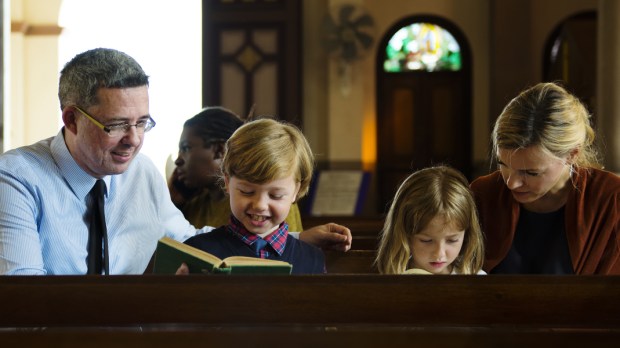In a new video called “4 Ways to Grow the Church,” Bishop Robert Barron says it is time to grow the Church and that we should each invite one person to Mass this year.
He’s right, and I think we can do so more confidently than ever. For too long, Catholics in America have sort of resigned ourselves to accepting that the Church is on the wane, secularism is ascendant, and that we are destined to be a tiny remnant of the faith that struggles forward.
This simply isn’t true. I plan to share a dozen reasons for hope, starting with three.
First, worldwide, religion isn’t dying. Secularism is.
To make this point I used to cite research from the 21st century in the books God Is Back and The Next Christendom. Recently, I’ve updated to 2015’s The Triumph of Faith, where sociologist Rodney Stark demonstrates, as the book’s subhead puts it: “Why the World Is More Religious Than Ever.”
“Surveys of more than a million people living in 163 nations show that … 81% claim to belong to an organized religious faith,” wrote Stark. “74% say that religion is an important part of their daily lives.”
There is a great positive story to tell here: There will likely be more churchgoers in China than in America by 2030.
India has five times as many Catholics as Ireland, which is impressive enough, but even more so when you remember that Indian people are the “new Irish,” traveling the globe as entrepreneurs, scientists, customer service agents, and more.
Perhaps the greatest story of all is Africa, where populations of Christians of all kinds, including Catholics, grew enormously in the 20th century — from 10 million Christians in 1900 to 400 million in 2000 — and are growing still.
Second, in America, Christianity isn’t collapsing.
A number of misunderstandings have left us such that we think that Christianity is worse off than it really is.
We start by overstating how religious America was in the past. It is true that there was a highly religious decade or two in America after World War II, and that we have fallen from that height. But this was not typical of our past.
At the end of the 20th century, Rodney Stark published The Churching of America which shared some remarkable statistics, including this great graph showing the steady rise of Christian adherence in America from less than 20% in 1770s to 61% in the 1990s.
If you think about it, it stands to reason. Popular literature from The Scarlet Letter to Huckleberry Finn and beyond disrespected religion, and the enlightenment rejection of religion was strong in American leaders from our nation’s founders to our school system’s founders.
But Gallup figures show that Church attendance in 2015 was about where it was in the early 1940s. It has gotten worse since 2015, I grant you. But the story is very different from what we think.
Third, nominal Christianity is dying.
In The New York Times, Ross Douthat pointed out in “The Overstated Collapse of American Christianity” that “Lukewarm Christianity may be declining much more dramatically than intense religiosity,” and that “The waning of Christianity may be still as much a baby boomer story as a millennial one.”
I like the way Ed Stetzer frames the issue by taking about three groups of Christians.
“Congregational Christians” are those who identify with a particular denomination. This number has been dropping for years.
“Cultural Christians” are those who don’t practice their faith but mark “Christian” on surveys. I always use the example of TV’s “Leave it to Beaver” Cleaver family and “Brady Bunch” family. No doubt if they were real, these families would have marked “Christian” on surveys. But we never saw them pray, mention church, or feature any kind of religious art. Today’s Cleavers and Bradys are exactly the same, only they no longer feel a need to mark “Christian” on surveys.
“Convictional Christians” are those who have committed their lives to Jesus and serve him. These are not in nearly as much trouble as the first two categories, as Robert Knight pointed out in the Christian Post 2020 and John Chalberg pointed out inCrisis magazine in 2021.
Rodney Stark told Knight that “The entire change [toward none-ness] has taken place with the non-attending group,” and that “This change marks a decrease only in nominal affiliation, not an increase in irreligion.”
There is bad news and good news here for Catholics.
The bad news for Catholics is, as Douthat put it, “There’s a strong case that any crisis facing Christian institutions is a more Catholic crisis than a Protestant one.”
The good news is that it’s clear why this is happening: Evangelical Christians have cultivated the habit of inviting people to their churches. We haven’t.
So let’s take up Bishop Barron’s request: He says every Catholic should invite one other person to Mass and start a dialogue about why. If we do that, the numbers will change dramatically — for the better.


